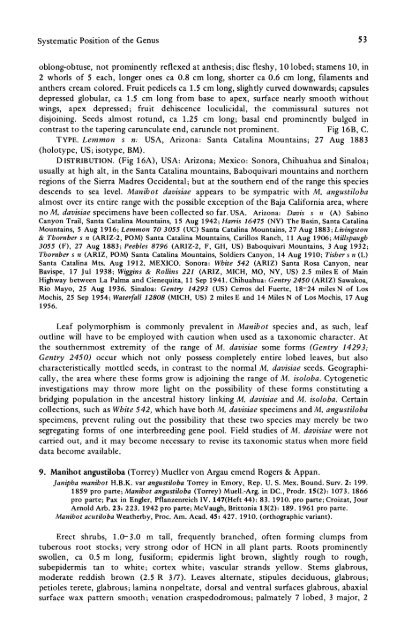Manihot Manihotoides (Euphorbiaceae) - CNCFlora
Manihot Manihotoides (Euphorbiaceae) - CNCFlora
Manihot Manihotoides (Euphorbiaceae) - CNCFlora
You also want an ePaper? Increase the reach of your titles
YUMPU automatically turns print PDFs into web optimized ePapers that Google loves.
Systematic Position of the Genus 53<br />
oblong-obtuse, not prominently reflexed at anthesis; disc fleshy, 10 lobed; stamens 10, in<br />
2 whorls of 5 each, longer ones ca 0.8 cm long, shorter ca 0.6 cm long, filaments and<br />
anthers cream colored. Fruit pedicels ca 1.5 cm long, slightly curved downwards; capsules<br />
depressed globular, ca 1.5 cm long from base to apex, surface nearly smooth without<br />
wings, apex depressed; fruit dehiscence loculicidal, the commissural sutures not<br />
disjoining. Seeds almost rotund, ca 1.25 cm long; basal end prominently bulged in<br />
contrast to the tapering carunculate end, caruncle not prominent. Fig 16B, C.<br />
TYPE. Lemmon s n: USA, Arizona: Santa Catalina Mountains; 27 Aug 1883<br />
(holotype, US; isotype, BM).<br />
DISTRIBUTION. (Fig 16A), USA: Arizona; Mexico: Sonora, Chihuahua and Sinaloa;<br />
usually at high alt, in the Santa Catalina mountains, Baboquivari mountains and northern<br />
regions of the Sierra Madres Occidental; but at the southern end of the range this species<br />
descends to sea level. <strong>Manihot</strong> davisiae appears to be sympatric with M. angustiloba<br />
almost over its entire range with the possible exception of the Baja California area, where<br />
no M. davisiae specimens have been collected so far. USA. Arizona: Davis s n (A) Sabino<br />
Canyon Trail, Santa Catalina Mountains, 15 Aug 1942; Harris 16475 (NY) The Basin, Santa Catalina<br />
Mountains, 5 Aug 1916; Lemmon 70 3055 (UC) Santa Catalina Mountains, 27 Aug 1883; Livingston<br />
& Thornber s n (ARIZ-2, POM) Santa Catalina Mountains, Carillos Ranch, 11 Aug 1906; Millspaugh<br />
3055 (F), 27 Aug 1883; Peebles 8796 (ARIZ-2, F, GH, US) Baboquivari Mountains, 3 Aug 1932;<br />
Thornber s n (ARIZ, POM) Santa Catalina Mountains, Soldiers Canyon, 14 Aug 1910; Tisher s n (L)<br />
Santa Catalina Mts. Aug 1912. MEXICO. Sonora: White 542 (ARIZ) Santa Rosa Canyon, near<br />
Bavispe, 17 Jul 1938; Wiggins & Rollins 221 (ARIZ, MICH, MO, NY, US) 2.5 milesE of Main<br />
Highway between La Palma and Cienequita, 11 Sep 1941. Chihuahua: Gentry 2450 (ARIZ) Sawakoa,<br />
Rio Mayo, 25 Aug 1936. Sinaloa: Gentry 14293 (US) Cerros del Fuerte, 18-24 miles N of Los<br />
Mochis, 25 Sep 1954; Waterfall 12808 (MICH, US) 2 miles E and 14 Miles N of Los Mochis, 17 Aug<br />
1956.<br />
Leaf polymorphism is commonly prevalent in Manibot species and, as such, leaf<br />
outline will have to be employed with caution when used as a taxonomic character. At<br />
the southernmost extremity of the range of M. davisiae some forms (Gentry 14293;<br />
Gentry 2450) occur which not only possess completely entire lobed leaves, but also<br />
characteristically mottled seeds, in contrast to the normal M. davisiae seeds. Geographically,<br />
the area where these forms grow is adjoining the range of M. isoloba. Cytogenetic<br />
investigations may throw more light on the possibility of these forms constituting a<br />
bridging population in the ancestral history linking M. davisiae and M. isoloba. Certain<br />
collections, such as White 542, which have both M. davisiae specimens and M. angustiloba<br />
specimens, prevent ruling out the possibility that these two species may merely be two<br />
segregating forms of one interbreeding gene pool. Field studies of M. davisiae were not<br />
carried out, and it may become necessary to revise its taxonomic status when more field<br />
data become available.<br />
9. <strong>Manihot</strong> angustiloba (Torrey) Mueller von Argau emend Rogers & Appan.<br />
Janipha manihot H.B.K. var angustiloba Torrey in Emory, Rep. U. S. Mex. Bound. Surv. 2: 199.<br />
1859 pro parte; <strong>Manihot</strong> angustiloba (Torrey) Muell.-Arg. in DC., Prodr. 15(2): 1073. 1866<br />
pro parte; Pax in Engler, Pflanzenreich IV. 147(Heft 44): 83. 1910. pro parte; Croizat, Jour<br />
Arnold Arb. 23: 223. 1942 pro parte; McVaugh, Brittonia 13(2): 189. 1961 pro parte.<br />
<strong>Manihot</strong> acutiloba Weatherby, Proc. Am. Acad. 45: 427. 1910. (orthographic variant).<br />
Erect shrubs, 1.0-3.0 m tall, frequently branched, often forming clumps from<br />
tuberous root stocks; very strong odor of HCN in all plant parts. Roots prominently<br />
swollen, ca 0.5 m long, fusiform; epidermis light brown, slightly rough to rough,<br />
subepidermis tan to white; cortex white; vascular strands yellow. Stems glabrous,<br />
moderate reddish brown (2.5 R 3/7). Leaves alternate, stipules deciduous, glabrous;<br />
petioles terete, glabrous; lamina nonpeltate, dorsal and ventral surfaces glabrous, abaxial<br />
surface wax pattern smooth; venation craspedodromous; palmately 7 lobed, 3 major, 2

















